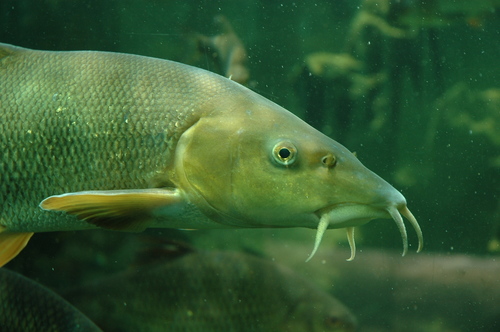
Common Barbel
The Bluefin Tuna (Thunnus thynnus) is a highly migratory species known for its incredible speed, size, and commercial value. Revered in culinary circles, especially for sushi, this species plays a critical role in marine ecosystems.
10 15 years
Lifespan
120 cm
Length
Least Concern
Conservation Status
15 km/h
Swimming speed
Omnivorous
Diet
Local Migration
Migration
Appearance Overview
The Bluefin Tuna is renowned for its large, streamlined body, built for speed and endurance in the open ocean.
Color
Dark metallic blue on top with a silvery underside
Fins
Two dorsal fins, the first depressible; a series of finlets behind the second dorsal and anal fins
Body Shape
Torpedo-like, facilitating swift movement through water
Length
up to 10 feet (3 meters)
Weight
up to 1,500 lbs (680 kg)
Diet
Carnivorous, feeding on fish, squid, and crustaceans
Feeding Behavior
Uses speed to chase down prey, sometimes in coordinated schools
Social Behavior
Solitary, migratory
Commercial Relevance
High value in sushi markets
Conservation measures
Fishing quotas, marine protected areas
Status
Endangered
Threats
Overfishing, climate change, habitat loss
Habitat Distribution
Depth Range
0-900 meters
Geographic Range
Atlantic Ocean, Pacific Ocean, Mediterranean Sea
Preferred Environment
Temperate waters, open ocean
Reproduction and Life Cycle
Breeding Habits
Spawns in warm waters, often near the Gulf of Mexico
Development Stages
Larvae hatch in plankton-rich waters and grow rapidly
Fecundity
Females can produce millions of eggs per season
Maturity Age
Matures at 4-8 years
Faqs about Common Barbel
Where can Bluefin Tuna be found?
Bluefin Tuna are found in the Atlantic and Pacific Oceans, and the Mediterranean Sea.
How long do Bluefin Tuna live?
They can live up to 40 years.
Are Bluefin Tuna used in sushi?
Yes, due to their high fat content and rich flavor, they are highly prized in sushi and sashimi.
What is the biggest threat to Bluefin Tuna?
They are primarily threatened by overfishing, which has severely depleted their populations.
What conservation efforts are in place to protect Bluefin Tuna?
Conservation efforts include strict fishing quotas, marine protected areas, and international agreements to monitor and manage tuna populations.
What do Bluefin Tuna eat?
They primarily feed on smaller fish, squid, and crustaceans.
How fast can Bluefin Tuna swim?
Bluefin Tuna can reach speeds of up to 43 mph (70 km/h).
Do Bluefin Tuna migrate?
They migrate across oceans for feeding and spawning, often covering thousands of miles.
How many eggs can a female Bluefin Tuna lay?
Females can produce millions of eggs per spawning season.
Are Bluefin Tuna warm-blooded?
Yes, they are warm-blooded, which helps them maintain high activity levels in cold waters.
Copyright @ Nature Style Limited. All Rights Reserved.
 English
English